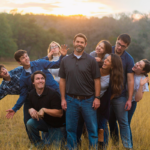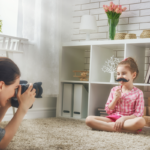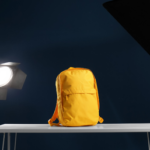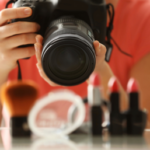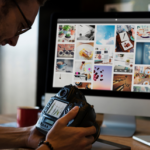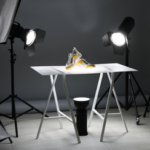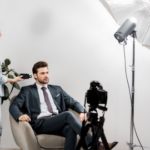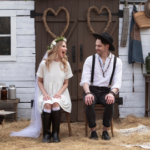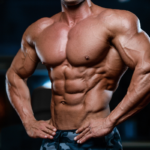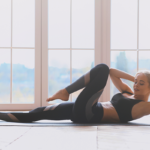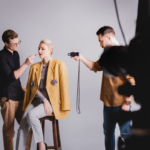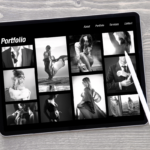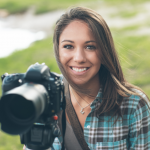Professional model headshots are arguably the most important photo a model needs for castings and jobs and is also the main shot in modelling digitals an aspiring model needs to submit to agencies. This makes it a highly sought after product that an amateur or professional photographer can provide. If you’re a photographer looking to venture out into modelling, or are simply looking to expand your skills and possibly make a bit of money on the side by taking model headshots, then you first have to understand the basic of what a headshot is, and what separates the good from the bad.
What Is A Model Headshot?
“Model headshots concentrate on the face, the body and the connection between the two.”
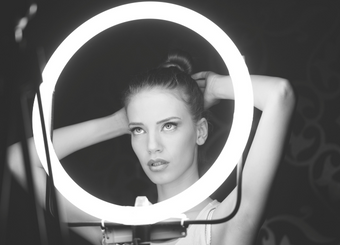 Model headshots differ significantly from the what most people associate with headshots – the acting headshot. Acting headshots are designed to emphasize expressions on the actor’s face and role type, where as model headshots on the other hand concentrate on the face, the body and the connection between the two.
Model headshots differ significantly from the what most people associate with headshots – the acting headshot. Acting headshots are designed to emphasize expressions on the actor’s face and role type, where as model headshots on the other hand concentrate on the face, the body and the connection between the two.
In order to take good headshots, its important to understand exactly what a model needs out of the photograph.
Professional models, or those looking to develop their modelling career, are always in the business of expanding their modelling portfolio, known as a model composite card. The composite card serves as the model’s portfolio and displays her latest and best pictures, including a full-body shot, a 3/4 image, and a close-up headshot.
When viewing model portfolio images, model agencies look to see a model in the most natural way and at all angles. This means that the majority of comp cards and model headshots will be taken with the model wearing outfits that highlight their figure, as well as light makeup that enhances their natural beauty. This is important to remember for photographers when shooting model headshots, as it is a reminder that the key to taking a good headshot is to ensure that the photos put the model in the best light.
Alongside this, it is also important for models to be themselves and not try to copy or be like someone else, which then also applies to photography.
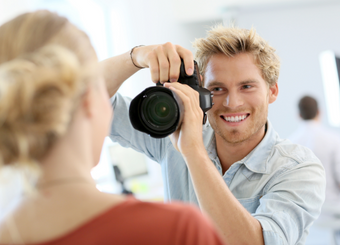 A photographer must understand that modelling agencies don’t want to have another model who is just like someone else in their clothing style or acts a certain way to fit in. They are looking for models who are individual in their looks and character, and so this individualism is what you should hope to be highlighting in any model photoshoot or headshot session.
A photographer must understand that modelling agencies don’t want to have another model who is just like someone else in their clothing style or acts a certain way to fit in. They are looking for models who are individual in their looks and character, and so this individualism is what you should hope to be highlighting in any model photoshoot or headshot session.
What Makes A Good Model Headshot
In acting it’s often thought too many shots in a headshot package can cause confusion on the character types an actor might be ideal for, but this is the opposite for modelling. Modelling portfolios often showcase many more shots in them than actor profiles do, and as such, the first step taking good headshots for models is to ensure that you’re taking as many as possible. Despite this difference, it’s more important to keep the idea of quality over quantity in mind.
As major commercial modelling campaigns are shot using high-end camera gear and lighting, it is important to ensure that your headshot’s are up to scratch in terms of lighting and visual fidelity so that your clients are taken seriously and your work is held in high regard. So, while it is important to take a large number of photos so your client has options when assembling their portfolio, it is even more important to ensure that every photo your provide your client with, is the best model headshot it could be.
How To Direct A Model
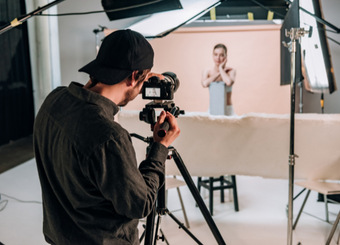 One thing that a lot of photographers overlook when taking headshots however, is posing, as this can seriously impact the success of a model headshot. A lot of times when models are just starting out, they don’t have many skills in posing or being in front of the camera, which is a shame as posing is key in a modelling career, since it shows that the model knows how to act in front of a camera.
One thing that a lot of photographers overlook when taking headshots however, is posing, as this can seriously impact the success of a model headshot. A lot of times when models are just starting out, they don’t have many skills in posing or being in front of the camera, which is a shame as posing is key in a modelling career, since it shows that the model knows how to act in front of a camera.
Luckily, even if you’re working with aspiring models, you as the photographer have the power to direct them in order to ensure that you’re producing the best headshots you can capture. Luckily, the key to directing posing models is quite simple – Turn the model’s head and body toward the light so the intricacies of their face are captured and the photo looks as aesthetically pleasing as possible.
As all photographers should know, flat lighting will make even the most pretty subject look unappealing, so ensure that your model is posing in a way that creates shadow, while also highlighting their best features.
Of course, be careful not to over step your boundaries.
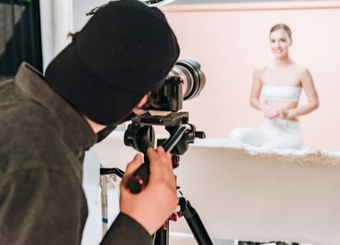 During a model photoshoot, it’s the model’s responsibility to know how to turn their body and pose for the shot, so don’t get too involved with directing, try to let the model do their thing. However, it is the photographer’s job is to capture the best shots they can, so if you see that some guidance is needed in order to improve a shot, then politely direct the model as best you can so you can get the best shot for both you and your model.
During a model photoshoot, it’s the model’s responsibility to know how to turn their body and pose for the shot, so don’t get too involved with directing, try to let the model do their thing. However, it is the photographer’s job is to capture the best shots they can, so if you see that some guidance is needed in order to improve a shot, then politely direct the model as best you can so you can get the best shot for both you and your model.
How A Professional Photographer Gets The Most Out Of A Headshot Session
“Make sure the eyes are crisp, sharp and dynamic in every shot you take.”
The first thing a professional photographer does when booking a professional model’s headshots, is to meet their subject in person, or at least talk to them on the phone, before the session. As most people dislike having their photograph taken and feel nervous about getting professional head shots, even professional models, this is a good way of making your client feel more at home with you. It will also give give you the chance to find out exactly what kind of portrait they’re after, be it super professional, fun or quirky.
The next thing to consider is the background you’re planning on shooting against.
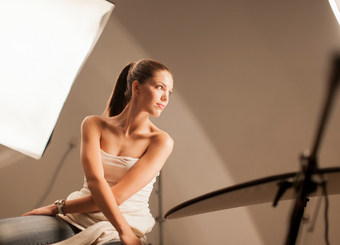 Although the focal point of any good headshot is obviously the face, don’t neglect the background when setting up. Plain or highly bokeh backgrounds usually work best, and be sure to watch for shadows if your subject is standing close to a wall or a screen, as this will make the photo look less professional, which can really detract from a professional model and their looks showcase in the shot.
Although the focal point of any good headshot is obviously the face, don’t neglect the background when setting up. Plain or highly bokeh backgrounds usually work best, and be sure to watch for shadows if your subject is standing close to a wall or a screen, as this will make the photo look less professional, which can really detract from a professional model and their looks showcase in the shot.
Once your background is sorted, the next thing to focus on is the eyes. Arguably the most important part of all professional model headshots is making sure the eyes are crisp, sharp and dynamic in every shot you take. Capturing eyes well will establish a strong connection between the photograph and the viewer, so a good way to get “fresh eyes” is to ask a subject to look away and then back into the lens right as you take the shot.
Finally, expression is everything when it comes to taking great professional model headshots. As the photographer, it is your job to find the most natural expressions of your subject and capture a look that’s unique to them, and the easiest way to do this is just to talk to them a lot. Ask your subject serious questions, crack jokes, give them direction, but most importantly constantly reassure them that they’re doing great. If someone feels they’re looking good and you’re getting the results you want, they’ll naturally relax and be themselves.
How To Keep Your Work Safe
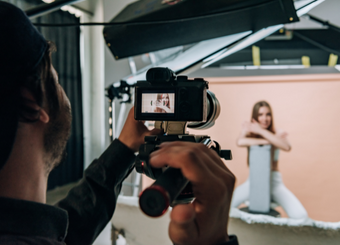 No matter what stage of the model photography process you’re in, a top priority for you should be to always keep your work protected from anyone who could be looking to steal, or misappropriate your work. This is where water marking comes in. Watermarking helps protect the copyright of your work and ensures that it cannot be reused or altered without your permission, making it one of the most sure-fire methods for a photographer to protect their work.
No matter what stage of the model photography process you’re in, a top priority for you should be to always keep your work protected from anyone who could be looking to steal, or misappropriate your work. This is where water marking comes in. Watermarking helps protect the copyright of your work and ensures that it cannot be reused or altered without your permission, making it one of the most sure-fire methods for a photographer to protect their work.
WaterMarquee is a powerful online tool, that allows you to add custom watermarks with your text and logo. You can also make multi-part watermarks and adjust the opacity and transparency of your watermarks, all in the one place. So if you want to protect your photos, do it with WaterMarquee today!


